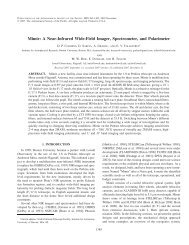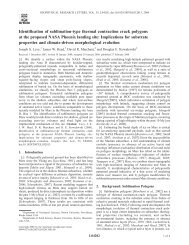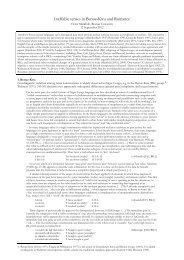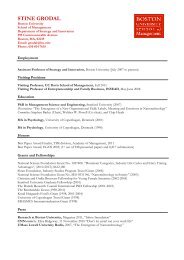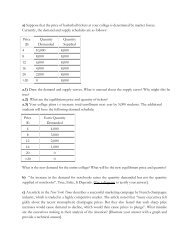Intertemporal Substitution and Recursive Smooth Ambiguity ...
Intertemporal Substitution and Recursive Smooth Ambiguity ...
Intertemporal Substitution and Recursive Smooth Ambiguity ...
You also want an ePaper? Increase the reach of your titles
YUMPU automatically turns print PDFs into web optimized ePapers that Google loves.
where the second equality follows from equation (42).Finally, we extend the above representation to the whole domain C × ∆(H).A riskequivalent always exists as discussed before. By a similar argument as in Appendix A2, forevery s t <strong>and</strong> every h ∈ H, there exists a one-step-ahead act h +1 ∈ H +1 such that h (s) <strong>and</strong>h +1 (s) are stochastically equivalent. We call h +1 the equivalent one-step-ahead act of h. ByAxiom B6 (Dynamic Consistency), we deduce(c, δ[h]) ∼ s t (c, δ[h +1 ]). (48)Suppose that p ∈ ∆(H) has a finite support {h 1 , h 2 , · · · , h m }, with p = ∑ i α iδ[h i ],α i ∈ (0, 1) , <strong>and</strong> ∑ i α i = 1. For each h i , i = 1, · · · , m, let h i +1 ∈ H +1 be its equivalentone-step-ahead act. Let p +1 ∈ ∆(H +1 ) be a probability measure with a finite supportsuch that the support is {h 1 +1, h 2 +1, · · · , h m +1}, <strong>and</strong> for each i = 1, · · · , m, p +1 ({h i +1}) =p({h i }).obtain (c, p) ∼ s tBy repeated applications of Axiom B4 (First-stage Independence) <strong>and</strong> (48), we(c, p +1 ). This relation is also true for arbitrary c ∈ C because of Axiom B2(Current Consumption Separability). By continuity of ≽ s t, the claim extends to arbitraryp. Hence, we haveV s t(c, p)= V s t(c, p +1 )( ∫ ∫(c, u −1 ◦ φ −1 H +1= W= W(c, u −1 ◦ φ −1 ( ∫H∫P s t( ∑∫)))φ π(s) u(V (c ′ , a ′ ))dh +1 (s)(c ′ , a ′ ) dµ s t(π)dp +1 (h +1 )s∈SC×∆(L)( ∑∫)))φ π(s) u(V s t ,s(c ′ , a ′ ))dh(s)(c ′ , a ′ ) dµ s t(π)dp(h) ,s∈SC×∆(H)P s twhere we have used the fact that h (s) <strong>and</strong> h +1 (s) are stochastically equivalent to derive thelast equality. Defining v = φ ◦ u, we obtain the representation as in the theorem.C3. Proof of UniquenessSuppose ({Ṽs t}, ˜W , ũ, ṽ, {˜µ s t}) <strong>and</strong> ({V s t}, W, u, v, {µ s t}) represent the same preference. Onthe domain of deterministic consumption streams C ∞ , all Ṽ s tfunction Ṽ <strong>and</strong> all V s tcoincide with the commoncoincide with the common function V . Since Ṽ <strong>and</strong> V are ordinallyequivalent over C ∞ , there is a monotone transformation Φ such thatṼ (y) = Φ ◦ V (y).for all y ∈ C ∞ . By (43), we have Ṽs t = Φ ◦ V s t.47



